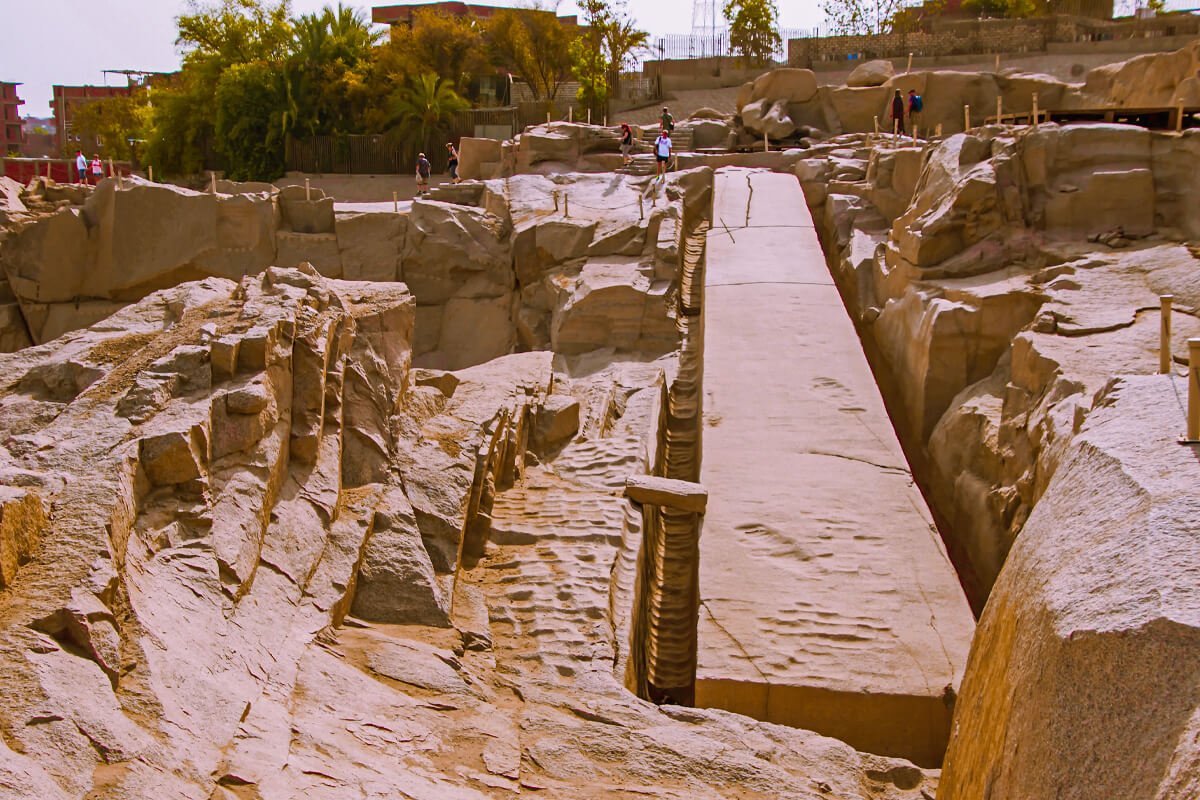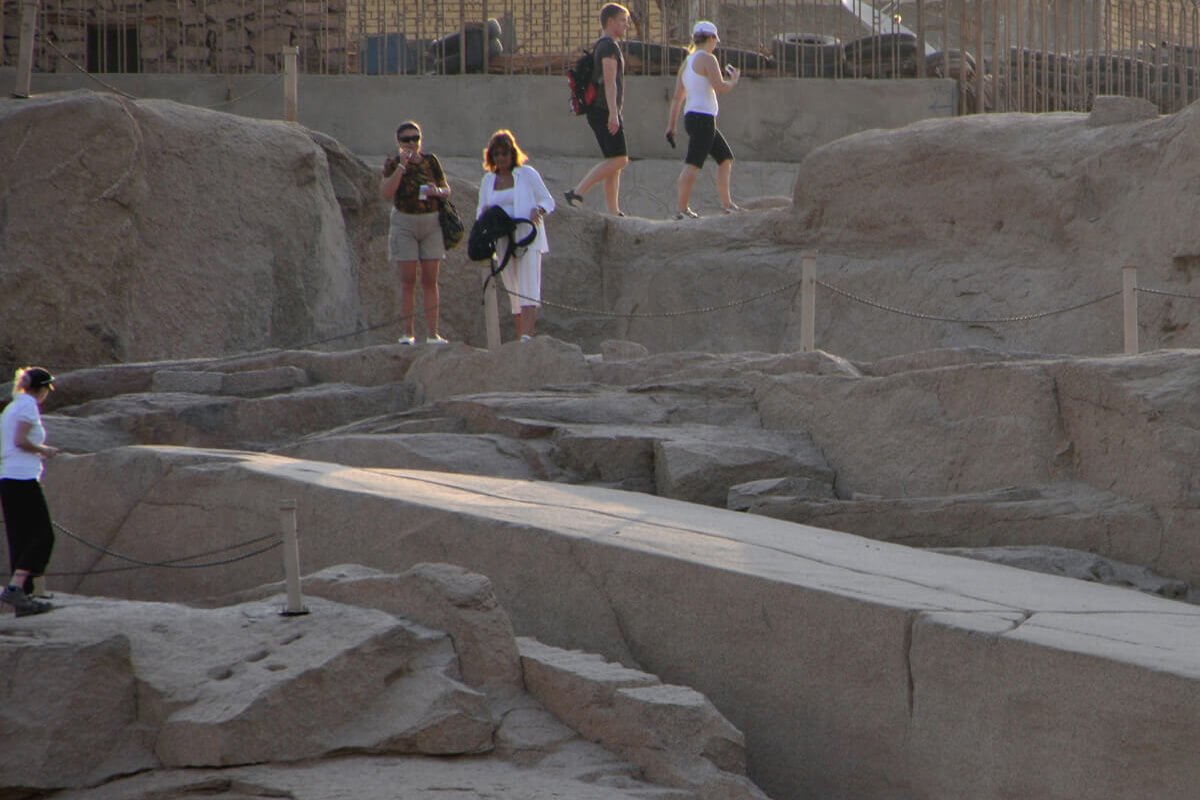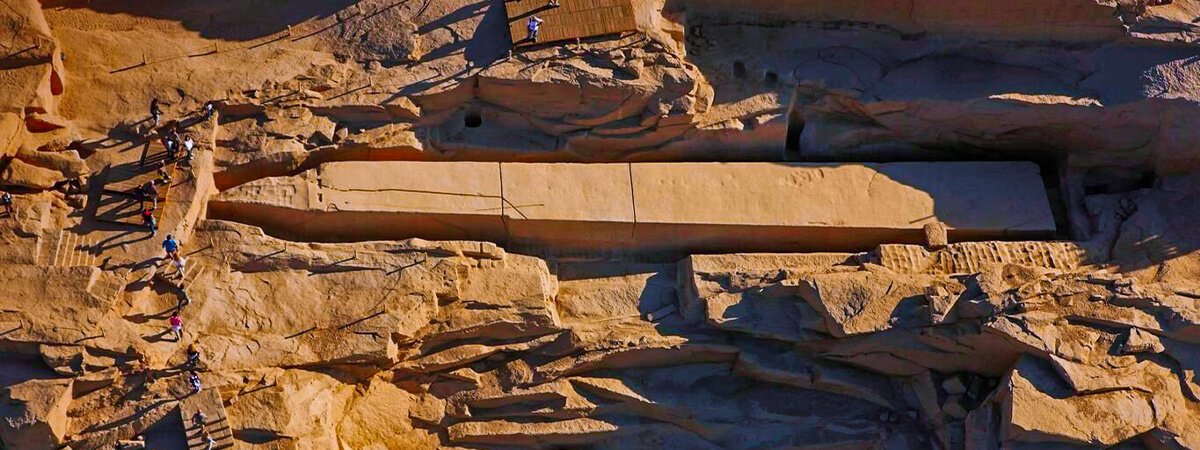Unfinished Obelisk: Revealing the Ancient Marvel
Welcome to the world of ancient marvels and mysteries! In this article, we delve into the intriguing tale of the Unfinished Obelisk. Standing tall amidst the old quarries of Aswan, Egypt, this unfinished monument offers a unique glimpse into the craftsmanship and techniques of the ancient Egyptians. Join us as we explore the history, construction challenges, and enigmatic legends surrounding the Unfinished Obelisk.
Discover Egypt’s ancient wonders! Book your Egypt Vacation Packages Now!
The Unfinished Obelisk: A Historical Marvel

Nestled in the ancient city of Aswan, Egypt, the Unfinished Obelisk stands as a testament to the incredible craftsmanship and ambition of the ancient Egyptians. This colossal monolith, though incomplete, tells a compelling story of a bygone era.
Historical background of the Unfinished Obelisk
In the world of ancient Egyptian architecture, obelisks held a special place. These towering, tapering structures were more than mere monuments; they symbolized power and spirituality. In the historical background of the Unfinished Obelisk, it’s crucial to understand that obelisks were erected as sacred objects, usually in pairs, to commemorate and glorify pharaohs and their deities. These towering stones were intricately carved with hieroglyphics and often adorned with gilded caps, reflecting the Egyptians’ deep-rooted religious beliefs and the grandeur of their civilization.
The discovery and excavation of the Unfinished Obelisk
The story of the Unfinished Obelisk took an unexpected turn in modern times. This colossal obelisk, carved from a single piece of granite, was left in a quarry due to an unforeseen flaw. In the mid-20th century, archeologists stumbled upon it, offering us a glimpse into the ancient Egyptian stone-cutting techniques. The discovery and excavation of this unfinished masterpiece opened a window into the remarkable skills of the artisans and the tools they used to shape these colossal stones.
The mystery of the Unfinished Obelisk’s abandonment
Despite the Egyptians’ prowess in stone carving, the Unfinished Obelisk remains a mystery. Why was this colossal undertaking abandoned? Some experts believe that a crack discovered during its creation rendered the obelisk structurally unsound and led to its abandonment. Others suggest it was too massive to be transported to its intended location, further fueling the debate. The mystery of the Unfinished Obelisk’s abandonment continues to intrigue historians and archeologists, and it stands as an enduring symbol of the ancient Egyptians’ grand ambitions and the limits of their technology.
Don’t miss checking out our article:
- Find out if Is it Safe to Travel to Egypt? and plan your adventure.
- Discover the Best Time to Travel to Egypt and book your journey.
Uncovering the Secrets of the Unfinished Obelisk
The colossal size of the obelisk
Standing tall, or rather lying elevated, the Unfinished Obelisk is truly a colossal marvel. Hewn from a single piece of granite, this monolithic structure is nothing short of awe-inspiring. It was intended to reach a staggering height of 42 meters (approximately 137 feet) and weigh around 1,168 metric tons. To put that into perspective, imagine a structure as high as a 14-story building and as heavy as over 200 fully grown African elephants. The sheer scale of the Unfinished Obelisk is a testament to the audacity and ambition of the ancient Egyptians.
Tools and techniques used by ancient Egyptians
Crafting such an immense obelisk required a mastery of stone-cutting techniques that still amaze us today. The ancient Egyptians employed various tools, primarily made of diorite and dolerite, to meticulously shape the granite. Chisels, hammers, and levers were their primary instruments, showcasing their innovative approach to stonework. The precision with which they chiseled away at the granite is a testament to their extraordinary craftsmanship. Their proficiency in stone carving, a skill passed down through generations, remains a fascination for archeologists and historians.
The quarry and the unfinished obelisk
The Unfinished Obelisk isn’t just about the obelisk itself; it’s also about the quarry it was born in. The quarry in Aswan, where this colossal structure was being hewn, is a mesmerizing site in its own right. Here, ancient Egyptians selected granite blocks, observing the natural fault lines to choose the ideal stone for their monumental projects. The quarry’s walls reveal a rich history of stone extraction, with remnants of other abandoned obelisks and artifacts. The unfinished obelisk lying amid the quarry’s rough terrain is a tangible link to the past, allowing us to step into the shoes of ancient artisans.
Theories on why the obelisk was left incomplete
One of the most intriguing aspects of the Unfinished Obelisk is the mystery surrounding its abandonment. Various theories attempt to explain why such an extraordinary undertaking was halted. The prevailing theory suggests that a significant crack in the granite was discovered during the carving process, rendering the obelisk unsuitable for its intended purpose. This theory aligns with the meticulous nature of the ancient Egyptians, who wouldn’t have wanted to compromise the structural integrity of such a significant monument. However, another school of thought argues that logistical challenges might have played a role, as moving a structure of this magnitude was no small feat. As you explore the Unfinished Obelisk, you can ponder these theories, each adding a layer of intrigue to this remarkable historical puzzle.

Join us for adventure and discovery on our Egypt Day Tours.
Unfinished Obelisk: A Geological Wonder
The granite quarry at Aswan
Hidden in the heart of Aswan, Egypt, lies a geological wonder that played an instrumental role in constructing ancient Egypt’s grand monuments. The Unfinished Obelisk, with its roots in the Aswan granite quarry, offers a unique insight into the world of geological history and ancient engineering.
Geology of the Unfinished Obelisk
Formation of granite: To truly appreciate the Unfinished Obelisk, one must first delve into the geology that shaped it. Granite, a type of igneous rock, is the key player here. It forms deep beneath the Earth’s surface as molten rock cools and solidifies. This slow cooling process allows granite to develop its distinctive crystalline structure, giving it remarkable durability and density. As a result, granite became the material of choice for the ancient Egyptians when creating their monumental structures.
The role of faults and cracks: The geological marvel of the Unfinished Obelisk lies not just in the choice of granite but also in the meticulous selection of a suitable granite block. The quarry in Aswan was strategically chosen for its unique geological features, including natural faults and cracks that facilitated the extraction process. Ancient artisans would study the granite, looking for these natural lines as a guide to where they would make their initial cuts. These lines would determine the size and shape of the obelisk. The knowledge of how to work with these natural formations was passed down through generations, making this process a harmonious fusion of geology and human ingenuity.
How the ancient Egyptians carved the obelisks
Creating an obelisk of this scale required more than geological knowledge; it demanded a profound understanding of the tools and techniques. The ancient Egyptians used tools, such as copper chisels, dolerite pounders, and wooden wedges, to carve and shape the granite. The craftsmanship displayed in the Unfinished Obelisk reveals a level of precision that’s both astounding and humbling. It’s a testament to the remarkable engineering skills of the time, as well as the deep cultural significance of obelisks in ancient Egyptian society. As you explore the Unfinished Obelisk, you can marvel not only at the colossal stone but also at the rich geological history and the ingenious techniques that the ancient Egyptians employed to craft their monumental masterpieces.
Visiting the Unfinished Obelisk
What to expect during your visit
As you prepare for your journey to the Unfinished Obelisk in Aswan, Egypt, it’s essential to know what to expect during your visit. This archaeological site provides a unique experience, immersing you in history and geology. When you arrive, you’ll find the massive obelisk in the quarry, partially carved from the granite bedrock. Take your time to appreciate the colossal size and precision of the ancient Egyptian craftsmanship. You can explore the quarry’s surroundings, where you’ll find remnants of other abandoned obelisks and tools that provide insights into the stone-carving process. The Unfinished Obelisk is a site that encourages reflection and contemplation, allowing you to connect with the past tangibly.
Guided tours and expert insights
For a richer experience, consider joining a guided tour of the Unfinished Obelisk. Knowledgeable guides can provide historical context, geological information, and fascinating stories about the quarry and the ancient artisans who worked here. Their expertise can illuminate the significance of the obelisk, the tools used, and the mystery of its abandonment. Expert insights help you appreciate the site’s importance in the context of ancient Egyptian culture and architecture. Guides can also share tales of the surrounding area and how it fits into the grand historical tapestry of Egypt. It’s an opportunity to learn and engage with history more deeply.
Recommended time for a visit
While the Unfinished Obelisk is a mesmerizing site, it’s not an all-day excursion. You can comfortably explore the area in about 1 to 2 hours, allowing you to take in the highlights, learn from the guides, and capture some stunning photographs. Since the quarry is close to other attractions, you can easily combine your visit with nearby sites, such as the Philae Temple or a cultural experience in a Nubian village. Planning your visit to the Unfinished Obelisk and its surroundings is an excellent way to make the most of your time in Aswan and immerse yourself in the wonders of ancient Egypt.

Nearby Attractions
Combining your visit with other Aswan attractions
When you plan a visit to the Unfinished Obelisk, you’re not limited to just this one awe-inspiring site. Aswan, a city steeped in history and culture, offers a wealth of nearby attractions to explore. Consider combining your visit to the Unfinished Obelisk with other must-see sites in the area. This way, you can make the most of your time in this enchanting part of Egypt.
Philae Temple: A nearby treasure
One of the most captivating nearby attractions is the Philae Temple. Situated on an island in the Nile River, this temple is a breathtaking display of ancient Egyptian architecture and spirituality. The temple complex, dedicated to the goddess Isis, was originally located on Philae Island but had to be relocated due to the construction of the Aswan High Dam. The meticulous relocation project preserved the temple’s intricate carvings and hieroglyphics, making it a fascinating historical treasure. Exploring the Philae Temple allows you to step into the world of ancient Egyptian religion and witness the dedication and ingenuity that went into preserving it for future generations.
Experiencing the Nubian culture
Aswan also offers a unique opportunity to immerse yourself in the vibrant Nubian culture. Nubia, the region to the south of Egypt, has a rich heritage distinct from the rest of the country. Visiting a Nubian village is an experience like no other. You can explore their colorful houses, taste traditional Nubian cuisine, and engage with the warm and welcoming Nubian people. It’s a chance to gain a deeper understanding of this fascinating culture, their customs, and their way of life. And don’t miss the opportunity to shop for Nubian crafts and souvenirs, which make for wonderful mementos of your trip.
Combining a visit to the Unfinished Obelisk with these nearby attractions not only enriches your itinerary but also allows you to delve into the diverse layers of history, culture, and natural beauty that Aswan has to offer. Whether you’re a history buff, a culture enthusiast, or someone looking for a unique travel experience, Aswan has something to offer every curious traveler.
Frequently Asked Questions
What is the significance of the Unfinished Obelisk?
The Unfinished Obelisk holds immense historical significance as it provides valuable insights into the stone carving techniques of ancient Egypt. It serves as a testament to the engineering prowess and craftsmanship of the ancient Egyptians.
How was the Unfinished Obelisk constructed?
The Unfinished Obelisk was carved directly out of the bedrock in the ancient quarries of Aswan. Ancient Egyptian artisans used diorite pounding balls and copper chisels to shape the granite stone, revealing the methods employed during that era.
Why was the Unfinished Obelisk abandoned?
The precise reason for the obelisk’s abandonment remains uncertain. While a crack in the stone halted its construction, the exact cause of the crash is still debated. Some theories suggest natural geological processes, while others propose factors such as the pharaoh’s death or economic constraints.
Can visitors explore the Unfinished Obelisk?
Yes, the Unfinished Obelisk is open to visitors. It offers a unique opportunity to witness firsthand the immense scale and intricacy of ancient Egyptian stone carving techniques. Visitors can marvel at the colossal size of the obelisk and gain insights into the challenges faced by ancient craftsmen.
Are there any other unfinished obelisks?
While the Unfinished Obelisk in Aswan is the most famous, other unfinished obelisks are scattered across Egypt. Some notable examples include the unfinished obelisks at the ancient city of Karnak and the Karnak quarries.
How does the Unfinished Obelisk contribute to our understanding of ancient Egypt?
The Unfinished Obelisk offers a unique glimpse into ancient Egypt’s advanced techniques and craftsmanship. By studying this remarkable structure, archaeologists and historians gain valuable insights into this ancient civilization’s engineering prowess, quarrying methods, and stone carving techniques.
Conclusion
As we conclude our exploration of the Unfinished Obelisk, we are left in awe of the ancient Egyptians’ mastery of stone carving and engineering. This monument, though incomplete, stands as a testament to their ambition and skill. The mysteries surrounding its abandonment only add to its allure. The Unfinished Obelisk serves as a captivating reminder of ancient Egypt’s remarkable achievements and enduring legacy.



